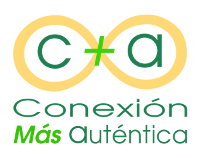Label: Videos
Video series for children, girls and adolescents made for UNICEF Spain
22 July 2020.
Tags: CI Spirals, Focusing, My Classifieds, My videos, For Teens, For boys and girls, For parents, Videos, Experiences
Since the beginning of the pandemic, many children's organizations have struggled to create resources. From Spirales Consultoría de Infancia we have prepared several different materials.
In this blog post I want to share some videos that are also relevant to what I am sharing here, for many reasons.
- They put forward messages that are clear and broad enough to discuss with children, girls and adolescents on the COVID-19 pandemic, so that they have clues about what is happening to them.
- They propose a work on body awareness: from the model of the three intelligences to coming into contact with the breath, with the tension or with the different sensations. It is not Focusing, but aim for that sensitivity.
- They are in Spanish, but also in French and Moroccan Arabic. I was excited to use in these videos these two languages that have served me so much to communicate when I lived in Morocco and with migrant adolescents in Spain.
I leave you the videos below:
I hope you find them interesting.
Trilogy “Human: The movie” Yann Arthus-Bertrand: to educate in listening
31 January 2016.
Tags: CNV, Interpersonal communication, Focusing, Videos, Experiences
I love to recommend works that are originally targeted to the general public for training in disciplines such intimate and profound as the Focusing and the Nonviolent Communication. This trilogy falls into that category.
“Human: The movie” It is a documentary trilogy as shows fragments of interviews with more than two thousand people (although in the final version of a selection of some two hundred people it appears) talking about all the things that make us “humans”. People of all ages (although very few children appear, and adolescents in proportion, and all of them very hard stories), of all kinds, from all continents. It is a sobering experience, very direct: no questions from interviewers, without dubbing (all interventions appear with subtitles, so you can hear the original voice), no source data of each person (In some cases only mentioned his country, but in most cases you can only intuit their continent, unless the subtitles are activated), bottomless (All interviews were made with the same dark background, although sometimes surrounding sounds are introduced). With people who listen and look at the camera while others speak, and nothing more. And occasionally, aerial views of breathtaking landscapes, natural landscapes and human landscapes, with world music (that are especially evocative when using without relation to the image: an African landscape with distinctly Asian music, for example, again underlining the universality of human).
Photographer and filmmaker Yann Arthus-Bertrand, He is known for his long career defending ecological and social causes, It has embarked on this magnificent trilogy, It intended as a further contribution to a portrait of a human being in its various dimensions. With its lights, and also with major shadows. The look of the film encompasses everything: from the best to the worst, freeing and enslaving, what it gives meaning and absurdities of modern life…
some thematic structure is perceived, which may be mentioned by way of guidance:
“Human: The movie (volume 1)”: love (in its various forms), work and poverty. Intense from the first minute, a reflection on these three elements of human life.
“Human: The movie (volume 2)”: war, homophobia, death and difficulties in the family. More clearly positioned in favor of human dignity in all situations, although it is difficult to recognize.
“Human: The movie (volume 3)”: the happiness, The education, disability, the relationship with the land, The meaning of life, justice and social action. A look at specific aspects that require our position (better for humanity, lets understand the message selection).
It is a work that deserves to be seen calmly, fragments of twenty or thirty minutes, to digest depth. It raises many questions and invites us to respond from the inside. you can also see extensive fragments of some of the people, which can be selected by their subject or message, and they include people who sometimes fail to appear in the film.
And those who see every film we can choose: ¿We classify each person according to the snippet of it? Or will we be able to hear opening, trying to see it with your feelings and your needs, with the feelings that must have in your life to talk like, with his humanity and his mystery?
I invite you to see movies and you to discover a little more of our shared humanity, and the human of each particular.
Xavier
“Connect with Respect” (“Respect for Me, Respect for You”), Bridget Belgrave material for Nonviolent Communication work with adolescents and young
18 September 2015.
Tags: CNV, Interpersonal communication, Education, Training, In English, Texts CNV, Videos
Last weekend 12 and 13 September 2015 I have had the privilege and pleasure of working again Bridget Belgrave. As I mentioned in this post, I met Bridget Belgrave already Gina Lawrie, Certified trainers for the Center for Nonviolent Communication (Center for NonViolent Communication, CNVC), in 2009 and from that moment we began to work together to translate NVC Dance Floors the Castilian. Completed translations finally saw the light in 2014, with some illustrative videos that can be viewed I made this entry for release. Association for Nonviolent Communication It has organized a series of training courses in Madrid, Bilbao and Barcelona during September 2015, and for me it has been a pleasure to work again with Bridget Belgrave support team with the translation from English into Castilian and vice versa.
In preparing the workshop I have spent time reviewing all the materials I have the NVC Dance Floors and of Bridget en particular. And valuing all materials, each with its wealth, there is one that is still my favorite. In fact, Bridget invited me to share my vision at some point of the workshop, and I happened also to extend my recommendation in this blog.
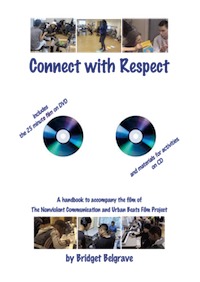 The material in question is only in English and not have subtitles or translations available, but I hope that does not discourage approach him. “Connect with Respect” (“Connect on respect”, literally translated into Castilian) is a multimedia material documenting a project that made Bridget Belgrave 2004 with 21 adolescents and young adults with an average age of seventeen. The project was proposed as an intervention to train boys and girls in situations of social difficulty Nonviolent Communication, within the framework of a workshop building urban rhythms, for ten weeks.
The material in question is only in English and not have subtitles or translations available, but I hope that does not discourage approach him. “Connect with Respect” (“Connect on respect”, literally translated into Castilian) is a multimedia material documenting a project that made Bridget Belgrave 2004 with 21 adolescents and young adults with an average age of seventeen. The project was proposed as an intervention to train boys and girls in situations of social difficulty Nonviolent Communication, within the framework of a workshop building urban rhythms, for ten weeks.
Why recommend? Here is a summary of my reasons:
- The DVD with the film, of 25 minute. Collect the key moments of the project, recorded therefore the three trainers as by young people themselves, and edited in collaboration with them. In fact, as told in a passage, the fact of viewing previous sessions helped them all become more aware of their own learning and getting behaviors that would be well suited to the needs of everyone. It is a graph document lets put faces (and sounds) to different situations, and lets figure out how to apply it in other contexts.
- The video is supplemented with the second part of the book, “Guide to the Film” (“Guide for the film”), on which sequence by sequence discussed everything that happens: each situation, how teaches Nonviolent Communication, Practice times, the real conflicts that arise… This will better understand the intent of each activity and the difficulties encountered and how they were addressed.
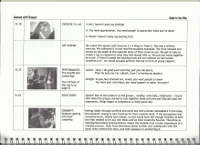
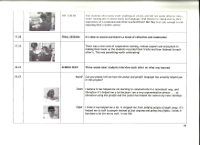
- And the third part of the book contains the complete program, ten weeks with all their detailed exercises and all materials also typeset (English), as well as incorporating a CD-ROM with the file of each material in PDF ready to print. Obviously the video does not collect all the exercises, so it is very useful to see the progression activity to activity, with the ability to replicate.
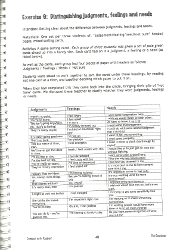
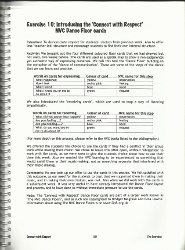
- The availability of a translation of what the Dance floor itself to Castilian, with title “Respect for Me, Respect for You”, within the complete package Dance Floors.
- And the caveat Bridget Belgrave not attempt a project of this type without having one hand a strong background and experience in Nonviolent Communication, and secondly an educational team with some basis of CNV and experienced in working with adolescents. I made some of these exercises with adolescents and youth at risk in Madrid and went well, so I'm available.
In summary, a material worth seeing, read, reread and implement. And you can buy in its online store, Life Resources.
And if you want more clarification, You can call me on my phone contact and discuss what you want.
I hope we can soon have more projects of this style here!
Xavier
Restorative Practices at school, a new way to resolve conflicts
5 May 2015.
Tags: CNV, Interpersonal communication, Education, In English, For parents, Texts CNV, Other Texts, Videos, Webs
Most disputes can be resolved in a satisfactory and beneficial way for all parties, provided that the necessary resources and time are dedicated. That's my personal and professional experience years learning, practicing and transmitting Nonviolent Communication. It's as basic (not easy) as the necessary conditions for that resolution occurs. For me there are several must-haves, which can be summarized as follows:
- An appropriate methodology, to allow all parties involved feel safe and respected in their rights.
- Professionals with experiential training in mediation and deep listening skills and “translation” messages to make them easier to listen to each person.
- A supportive community restorative processes, devoting time, spaces, human Resources, training…
- People willing to resolve conflicts in a way that ultimately all parties feel heard and that all parties leave satisfied with the solution.
So for me it is a joy to share the resources developed by a large community of people in the neighborhood are Gotleu in Palma de Mallorca (Mallorca), They are collecting and how they have worked each of those elements.
In this video you can see how they have been involved, with the revitalization of Institute for Coexistence and School Success (the Institute for Coexistence and School Success in Castilian) Government of the Balearic Islands, from the faculty of schools of Primary Education, Elementary and Secondary, students of all ages, the families, and Social Services, police, University and other significant social groups. A mosaic of voices, We make us an idea of the experiences of the creation of that network security in a socially vulnerable environment, and we see some results.
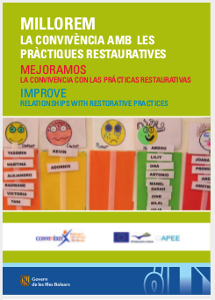 For a more systematic view, is the publication containing the fundamentals. Published in Catalan, Castilian and English as part of a European project this subject, the Guide to improve coexistence with Restorative Practices / Guide Mejoramos coexistence with the practices restorative develops the theoretical aspects of Restorative Practices, more accurate data and provides concrete examples and suggestions for further reading for more information.
For a more systematic view, is the publication containing the fundamentals. Published in Catalan, Castilian and English as part of a European project this subject, the Guide to improve coexistence with Restorative Practices / Guide Mejoramos coexistence with the practices restorative develops the theoretical aspects of Restorative Practices, more accurate data and provides concrete examples and suggestions for further reading for more information.
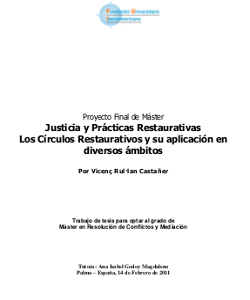 And to deepen the Restorative Circles, a practice of conflict resolution originated in the social dimension Nonviolent Communication, you can read the interesting monograph Justice and Restorative Practices. Restorative Circles and their application in various fields, written by Vicenç Rul·lan, a trainer who I have the pleasure of meeting, on the video and in the Guide, and he is a member of the Association of Restorative Justice Practices and Islands (to page Castilian and in Catalan, with several resources more). A good introduction, to further deepen this particular model. And you can also watch videos (English) on the official website of the creator of the Restorative Circles, Dominic Barter, RestorativeCircles.org.
And to deepen the Restorative Circles, a practice of conflict resolution originated in the social dimension Nonviolent Communication, you can read the interesting monograph Justice and Restorative Practices. Restorative Circles and their application in various fields, written by Vicenç Rul·lan, a trainer who I have the pleasure of meeting, on the video and in the Guide, and he is a member of the Association of Restorative Justice Practices and Islands (to page Castilian and in Catalan, with several resources more). A good introduction, to further deepen this particular model. And you can also watch videos (English) on the official website of the creator of the Restorative Circles, Dominic Barter, RestorativeCircles.org.
Who have done some training of interpersonal communication with me you have seen that ground mention this issue of Restorative Practices. I hope these resources illustrate a little better what you have heard me and I hope to awaken your creativity and your imagination to continue discovering more effective and deeper ways to resolve conflicts in the educational environment, and in any other area.
Xavier
I understand how psychotherapy: Key ideas and a video to illustrate
3 March 2015.
Tags: Interpersonal communication, For Teens, For boys and girls, For parents, Psychotherapy, Therapy, Videos
Explain to anyone what the psychotherapy, and especially what I understand as psychotherapy, It is always a challenge. And when this is added we want to explain it to children, or adolescents, It finds it harder. And yet, psychotherapy is perfectly natural: to recover the lost balance (and thus regain control of their lives).
As human beings we are basically ready to grow healthily. It would be natural that all people might be moving through the various stages of childhood, adolescence and adulthood step. It would be natural, well, on the one hand to incorporate the nutrient elements psychologically (body, emotional, cognitive, procedural, attitudinal…) and on the other hand trying to overcome the painful and even harmful elements with new learning (of the kind “This attitude of mine and does not serve me” The “I do not ever want to deal with a person who does not respect me”). However, Sometimes things go wrong (a little or a lot), and you need to do something to move forward with health. Psychotherapy is a good way to integrate and heal the experiences, regaining enthusiasm for our life.
The video “Garra rufa (Doctor Fish)”, It was developed by a group of students of animation Sheridan College under the name of Frozen Mammoth Productions, among others Timothy Chan and Eunice Hwang, and we can serve as the starting point to begin reflection.
This video seems a good example to explain several key points that I like to make clear to children and adolescents, and also adults who pose make a psychotherapy:
1) The work of those who act as therapists is recover the healthy and alive who's inside we see. We all have something valuable by the mere fact of its existence, although sometimes very harmful situations have occurred, the external internal.
2) To recover what we have healthy and alive variety of means, Suitable whom we have before (and at his age, their likes, his style, what has lived…). always we hear, often we ask, and sometimes we propose activities (how to draw, or perform specific activities, or trying different techniques). Our goal is to give back to the person that he is healthy and alive, but cleaner and stronger so you can move your life.
3) We know that the process takes time. If we take weeks, months, years, living with painful, we will also need time to heal dedication. It is true that there may be discoveries that we radically change our experience at a time, as it appears in the video, but that only happens when we have been investigating our inner enough. And it takes time for that experience is put in place globally in our lives.
4) And we know that The process involves an effort. It's like cleaning a wound that has become infected, It may involve momentary pain, but the improvement is evident in the long run. The effort affects people who are around who comes for consultation. For children, and adolescents, the effort affects the family, and from my vision of psychotherapy I intervene only if there is a clear and strong commitment from family (especially primary caregivers).
5) As in the video, as therapists know well the experience because We have lived our own psychotherapy with our own challenges. Of course we have specific training, broad and deep, but we do not consider exceptional people. We are simply people who have watched our pain and we have learned to look at the pain of others constructively and from new perspectives.
I hope the video will serve you to have some clearer ideas about psychotherapy, especially when you please explain the your children, and adolescents.
Xavier
A Nobel Peace Prize to the defense of children from Nonviolence
17 October 2014.
Tags: Other Texts, Videos, Webs
From this post I want to celebrate the Nobel Peace Prize 2014 It has been awarded to two people who defend the rights of children, and adolescents from Nonviolence.
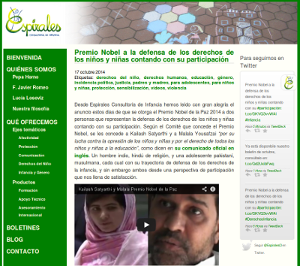 For me it was a joy to know that they will receive Kailash Satyarthi, an Indian man defender of the rights of children, especially those working, y Malala Yousafzai, a Pakistani teenager who has fought for the right to education of children and especially girls. From blog Spiral Consulting Children we have made a specific entry where we give more details of the aspects that interest us there: work by children from participation. I invite you to read the entrance, where we give them a lot of data and video you can see both.
For me it was a joy to know that they will receive Kailash Satyarthi, an Indian man defender of the rights of children, especially those working, y Malala Yousafzai, a Pakistani teenager who has fought for the right to education of children and especially girls. From blog Spiral Consulting Children we have made a specific entry where we give more details of the aspects that interest us there: work by children from participation. I invite you to read the entrance, where we give them a lot of data and video you can see both.
Since this blog however I want to discuss how to address both Nonviolence. And how they do it from compassion, but also with great force. They speak not from weakness or from cowardice. And said Gandhi “Between violence and cowardice, I prefer violence”, and then showed he had an even more powerful way that both, Nonviolence. I see this in Kailash and Malala.
Kailash Satyarthi, whom I had the honor of meeting a few years ago at a conference on child rights, It has a close relationship, with interest for what we do other professionals. He considers himself heir to the line of Gandhi Nonviolence, and it has been coordinating multiple events both at home and globally, thanks to his skills of listening and inclusion of all parties involved. And that has not been dusted force to rescue children from exploitative workers, relying on the police forces of India and risking their physical integrity (He has repeatedly suffered injuries and loss of co-rescue).
Malala Yousafzai He became famous for starting a blog to defend the right to education, especially education of girls like her, in an area occupied by Pakistan Taliban. As a result of that the Taliban tried to kill, but fortunately he has survived and is still being formed, but in the UK. Malala continues to lecture, as she says, “education for all children, including of course the sons and daughters of the Taliban”. And he says in the video how at the time, when he was threatened with death, I thought about how to respond, and how he decided he did not want to take the line of attack because then it would become the same one who assaulted him.
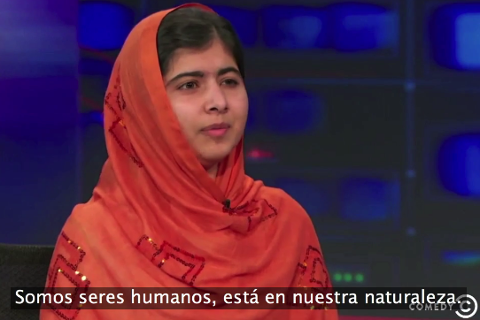 So it has filled me with satisfaction the recognition of two people and two ways of being different (the man, woman she; The adult, her teen; the Indian, She Pakistani; The Hindu, she Muslim), which however they are based on a compassionate and strong look to both human realities, and lead to concrete commitments and results, Step by Step. In fact they have already expressed interest in working together, but they were not previously known.
So it has filled me with satisfaction the recognition of two people and two ways of being different (the man, woman she; The adult, her teen; the Indian, She Pakistani; The Hindu, she Muslim), which however they are based on a compassionate and strong look to both human realities, and lead to concrete commitments and results, Step by Step. In fact they have already expressed interest in working together, but they were not previously known.
I leave this post in celebration, and also as inspiration. Really from human beings we can find a path to a more authentic connection, and to take effective steps to solve very real and concrete problems.
I invite you to investigate a little more about Kailash and Malala, and that you enjoy with the mind that can bring us.
Xavier
Note: it is interesting that there is a line of work Focusing from the community in Afghanistan and Pakistan, in areas that have been hardest hit by the Taliban, to restore the social fabric and the connection through local Sufi traditions, with the extra dimension provided by the Focusing. I do not think Malala knows this job, but there is another inspiration more.
NVC Dance Floors: practice Nonviolent Communication in a holistic manner
25 September 2014.
Tags: CNV, Interpersonal communication, Education, In English, My Classifieds, For Teens, For boys and girls, For parents, Psychotherapy, Therapy, Texts CNV, Videos
The NVC Dance Floors have already appeared in the version in Castilian, in which I have worked, and are also available videos subtitled in Spanish.
Bridget Belgrave and Gina Lawrie, Certified trainers for the Center for Nonviolent Communication (Center for NonViolent Communication, CNVC), years they created a great tool to teach and practice Nonviolent Communication (CNV). As they themselves have in submission, the NVC Dance Floors (NVC Dance Floors) They emerged through a series of steps to facilitate the practice of Nonviolent Communication with a spatial maps that allow use body size to work the emotional dimension, the way you see in this video:
In summer 2009 formarme had the pleasure to meet with Gina and Bridget, From there already work resumed translation and adaptation to the Castilian, an effort in which we have helped many people and I have coordinated for a while. So it is a pleasure to spread a simple tool and yet so deep, finally in Spanish, in which we care to include the largest possible number of Spanish version.
My experience is that the NVC Dance Floors the people can practice with just a few initial knowledge of Nonviolent Communication (In fact I sometimes use in introductory workshops). Even people who do not know the process of Nonviolent Communication itself (children, and adolescents, therapy clients) They can easily cross it with help from someone more experienced.
The NVC Dance Floors combine the visual, corporal and language, so that experience occurs through more channels and experience is deeper. And there are nine “dances” different, with names such as “The Dance of the 13 Steps”, “Integration and Dance Connection”, “The Dance of Anger / Rage, Shame and Depression”, “Dance of Yes and No”, The “Transform the pain of unmet needs in the Beauty Needs”.
Further, in 2013 they released some videos that explain three of these dances, in a neat edition that includes Spanish subtitles.
If you want to buy the dance floor CNV in different formats (as a download in PDF, on paper, plasticized version…) and DVDs to learn them at home or in group practice, you can visit its online store, Life Resources.
And if you want to count on me to try the dance floor in one session or in specific workshops, I will be happy to accompany.
I hope you like.
Xavier
Video of Dan Pink on myths and realities of human motivation">Video of Dan Pink on myths and realities of human motivation
7 January 2014.
Tags: Education, CI Spirals, For parents, Videos
As I commented in this entry from the Spiral Consulting Children's blog, talking about education a few weeks ago I found myself mentioning again that rigorous scientific studies show that prizes and rewards work very short time and basically destroy intrinsic motivation in people, children, and adolescents included. Since the texts are usually operating primarily in English (if you insist I will make a post about them), I started researching to see what resources could be found in Castilian, and I was lucky to run into this magnificent video.
and Pink, after working writing for Al Gore, He became a writer and consultant on creativity. In her video she speaks of motivation in business, but if you substitute the word “company” by “school” every time, It will provide a fascinating insight into the educational reality (in our country and the world in general). To focus a little issue, the motivation (what drives us people to do things, whatever they are) can be “intrinsic” (when it is born of our own inner, as when we are curious, commitment, intentions contribution…) The “extrinsic” (when is a response to external conditions such “If you receive you beam A B”, whether B is a reward or a punishment).
I love that video, as he says, no one “feelings” to share even a “philosophy” to believe, but hard facts, contrasted by an entity so little suspicious “alternative” as the Federal Reserve Bank of Boston: “in eight out of nine tasks, the highest incentives (positive) They led to worse performance”. A) Yes. Why every time I hear that someone wants to reward or punish a child, or girl, I am worried. Will they use punishment or reward in that way that serves (one in nine), or they are undermining a little more intrinsic motivation of the person you want to educate? And I like the fact that the video continues with a proposal, brief but suggestive, how it works intrinsic motivation. Y, what a coincidence!, it turns out that this model of intrinsic motivation also works for human relations in general and schools in particular. I speak from experience, working for years with teenagers at social risk.
So nothing, Here's the video, and I love reading your comments.
Xavier
Change the world gesture gesture
6 January 2014.
Tags: For Teens, For boys and girls, For parents, Videos, Experiences
The beginning of the year is a time of good intentions, new projects and renewed hopes. All these early steps will need, perhaps very small steps at first. This video captures the idea of changing the world gesture gesture.
There are times for big moves, for radical changes, Greatest Hits for rudder.
And there are also times for small changes, for modification of detail, for “do the same but in a different way”.
The story of this video is that the Czech organization The intersection of Olomouc reorganizes a series of advertisements Liberty Mutual, an insurance company has made over the years a number of advertising campaigns to enhance public accountability. In this adaptation the little things we can do every day to make the world a little better collect, regardless of ideological positions or any. And we knew that they might not get from the people we help (although reciprocity is critical to the fundamental relations), as in the video, but our actions can inspire others, and will probably never know the fruit.
I wish you happy 2014, with awareness and significant contributions to the world.
Xavier
Alex Rovira Video on the Economics of caresses
30 May 2013.
Tags: CNV, Education, Focusing, Videos, Experiences
Alex Rovira, business advisor, lecturer and writer both as a novel test, has a positive view of the human being is very close to what we have from the Nonviolent Communication and Focusing.
In this short video gives some basic keys to working with people, both business management and for those who intervene more in the personal and social. The key phrase “Stroke economy” reflects one of the basic concepts that I try to convey in my work training and support: people seek to be seen, be recognized, and if they get through what we seek positive through most unpleasant reprimands. The key is to be aware of this and learn to read between the lines. To me this helps me in my work with adolescents and their families, and is the primary tool for building bridges between people.
The intention that it veáis video (repeatedly, even, to capture the subtleties) and introduce you to reflect on how the stroke economy in our private life, and also in the professional.
Hope you enjoy the.
Xavier
